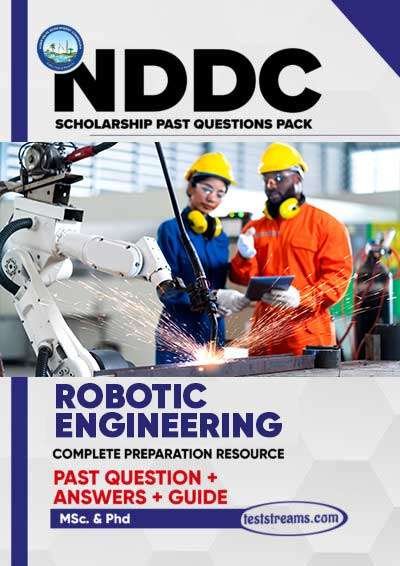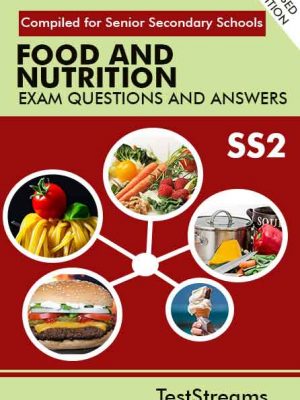NDDC Scholarship Past Questions And Answers – Robotic Engineering
As the world continues to advance in technology and innovation, fields like Robotic Engineering have become increasingly relevant. The Niger Delta Development Commission (NDDC) recognizes the importance of fostering education and research in emerging fields, and as a result, they have been offering scholarships to students pursuing Robotic Engineering. In this blog post, we will delve into the NDDC Scholarship program, its significance, and how past questions and answers can help aspiring scholars.
Understanding NDDC Scholarship
The Niger Delta Development Commission (NDDC) is an agency established with the goal of facilitating the rapid and sustainable development of the Niger Delta region in Nigeria. To achieve this objective, the NDDC offers scholarships to deserving students who wish to pursue higher education in various fields, including Robotic Engineering.
The NDDC scholarship is a prestigious opportunity for students in the Niger Delta region to access quality education and make a positive impact on their communities and the world at large. One of the key requirements for this scholarship is a competitive entrance examination, which often includes questions related to the chosen field of study.
Why Past Questions and Answers Are Important
Preparing for any scholarship examination can be a daunting task, especially in a field as dynamic and demanding as Robotic Engineering. However, the use of past questions and answers is an invaluable resource for scholarship applicants. Here are a few reasons why:
- Familiarity with Exam Format: NDDC often recycles certain question patterns in their scholarship exams. Studying past questions helps you become familiar with the format of the examination and the types of questions that might appear.
- Content Coverage: Past questions often provide insight into the specific topics and subject areas that the examiners prioritize. This allows you to focus your studies on the most relevant material.
- Time Management: Practicing with past questions and answers can help you develop effective time management skills. You’ll learn to allocate your time wisely during the actual exam.
- Confidence Boost: Solving past questions successfully boosts your confidence, reducing exam anxiety and enhancing your overall performance.
- Identifying Weaknesses: Going through past questions can help you identify areas where you need more preparation, allowing you to concentrate on your weaknesses.
This study pack contains:
- All the official NDDC (MSc) Scholarship Aptitude Test Past questions and answers from 2010 to 2023
- Well structured 2021 & 2023 official past questions for Robotic Engineering Discipline
- Free current affairs ebook (Worth N1000)
- The complete cinfores questions bank from where 2012 – 2023 questions were drawn.
- Detailed Oil and Gas industry study note, and most importantly, beyond the aptitude test stage, You will be getting our exclusive copy of NDDC scholarship interview guide with insider tips on how to pass the interview stage with ease.
Sample Past Questions and Answers for NDDC Scholarship – Robotic Engineering
VERBAL REASONING
Question 1:
Which of the following best describes the relationship between robotics and artificial intelligence?
A) Robotics is a subset of artificial intelligence.
B) Artificial intelligence is a subset of robotics.
C) Robotics and artificial intelligence are unrelated.
D) Robotics and artificial intelligence are closely interconnected.
Answer: D
Question 2:
In the context of robotic engineering, what does the acronym “PID” stand for?
A) Proportional-Integral-Derivative
B) Programmable Industrial Device
C) Path Integration Decision
D) Particle Identification Detector
Answer: A
Question 3:
Select the synonym for “automate.”
A) Humanize
B) Mechanize
C) Complicate
D) Analyze
Answer: B
Question 4:
Which of the following best represents the primary advantage of using swarm robotics in applications like agriculture?
A) High individual robot cost
B) Centralized decision-making
C) Robustness and redundancy
D) Limited scalability
Answer: C
Question 5:
What term is commonly used to describe a robot’s ability to sense and adapt to its environment?
A) Autonomy
B) Mechanical rigidity
C) Inefficiency
D) Obsolescence
Answer: A
Question 6:
In robotic engineering, what is the purpose of a gripper?
A) To process sensor data
B) To control locomotion
C) To manipulate objects
D) To generate power
Answer: C
Question 7:
Which of the following materials is commonly used for the construction of robotic exoskeletons?
A) Glass
B) Paper
C) Steel
D) Carbon Fiber
Answer: D
Question 8:
In the context of robotics, what does the term “haptic feedback” refer to?
A) Visual information
B) Tactile or force feedback
C) Auditory cues
D) Spatial mapping
Answer: B
Question 9:
What is the primary purpose of a LiDAR sensor in robotics?
A) Detecting temperature changes
B) Measuring distances and creating maps
C) Analyzing speech
D) Controlling robot emotions
Answer: B
Question 10:
In robotic path planning, what does “SLAM” stand for?
A) Simultaneous Localization and Mapping
B) Systematic Learning and Mapping
C) Sensory Localization and Measurement
D) Sequential Learning and Movement
Answer: A
Mathematics
Question 1:
What is the formula for calculating the circumference (C) of a circle with radius (r)?
A) C = 2πr
B) C = πr^2
C) C = π/2r
D) C = 2r
Answer: A
Explanation: The formula for the circumference of a circle is C = 2πr.
Question 2:
A robot moves 8 meters forward and then 3 meters backward. What is its net displacement?
A) 5 meters
B) 11 meters
C) 8 meters
D) 24 meters
Answer: A
Explanation: The net displacement is the difference between the initial position and the final position. In this case, it’s 8 meters – 3 meters = 5 meters.
Question 3:
If a robotic arm has a maximum angular velocity of 60 degrees per second, how many degrees will it rotate in 5 seconds?
A) 120 degrees
B) 300 degrees
C) 60 degrees
D) 15 degrees
Answer: B
Explanation: Angular displacement (θ) = Angular velocity (ω) x Time (t), so 60 degrees/second x 5 seconds = 300 degrees.
Question 4:
A robot’s battery can power it for 4 hours continuously. If the robot has been operating for 2.5 hours, how much operating time remains?
A) 1.5 hours
B) 4 hours
C) 6.5 hours
D) 2.5 hours
Answer: A
Explanation: Remaining operating time = Total operating time – Time already operated = 4 hours – 2.5 hours = 1.5 hours.
Question 5:
If a robot travels at a constant speed of 2 meters per second, how far will it travel in 10 seconds?
A) 20 meters
B) 5 meters
C) 12 meters
D) 200 meters
Answer: A
Explanation: Distance (d) = Speed (v) x Time (t), so 2 m/s x 10 s = 20 meters.
Question 6:
In a robotic control system, if the input signal is 6 volts and the amplification factor is 3, what is the output signal voltage?
A) 2 volts
B) 18 volts
C) 3 volts
D) 9 volts
Answer: B
Explanation: Output voltage = Input voltage x Amplification factor = 6 volts x 3 = 18 volts.
Question 7:
A robot arm has a mass of 10 kg and is subjected to a gravitational acceleration of 9.8 m/s². What is the gravitational force acting on the robot arm?
A) 98 N
B) 0.98 N
C) 10 N
D) 9.8 N
Answer: A
Explanation: Gravitational force (F) = Mass (m) x Gravitational acceleration (g), so 10 kg x 9.8 m/s² = 98 N.
Question 8:
If a robotic vehicle travels at a speed of 30 kilometers per hour (kph), how many kilometers will it travel in 2.5 hours?
A) 75 km
B) 12 km
C) 75 m
D) 120 km
Answer: A
Explanation: Distance (d) = Speed (v) x Time (t), so 30 kph x 2.5 hours = 75 km.
Question 9:
A robotic arm moves from position A to position B, covering a distance of 15 meters in 10 seconds. What is its average speed?
A) 1.5 m/s
B) 25 m/s
C) 150 m/s
D) 0.15 m/s
Answer: A
Explanation: Average speed = Total distance / Total time = 15 meters / 10 seconds = 1.5 m/s.
Question 10:
A robot’s processing unit can perform 500,000 calculations per second. How many calculations can it complete in 2 minutes?
A) 30 million
B) 60 million
C) 1 million
D) 2.5 million
Answer: B
Explanation: Calculations completed = Calculations per second x Time (in seconds), so 500,000 calculations/second x (2 minutes x 60 seconds/minute) = 60 million calculations.
PRODUCTION ENGINEERING.
ELECTRICAL ENGINEERING
AGRICULTURAL ECONOMICS
CIVIL ENGINEERING
MECHANICAL ENGINEERING
MEDICAL SCIENCE
MANAGEMENT SCIENCE
EDUCATION AND HUMANITIES.
FISHERIES
GEOLOGY.
JOURNALISM
CHEMISTRY
BIOCHEMISTRY
CHEMICAL ENGINEERING.
BIOLOGY
COMPUTER ENGINEERING










